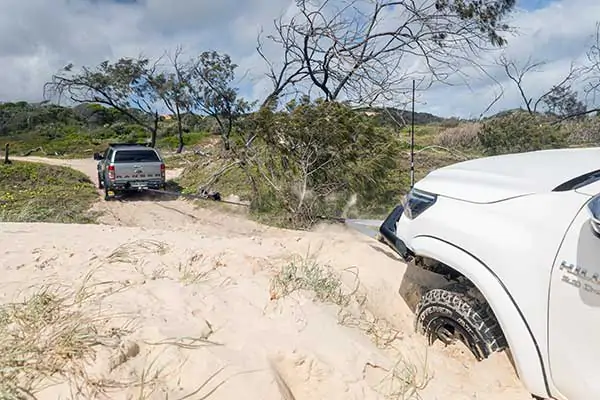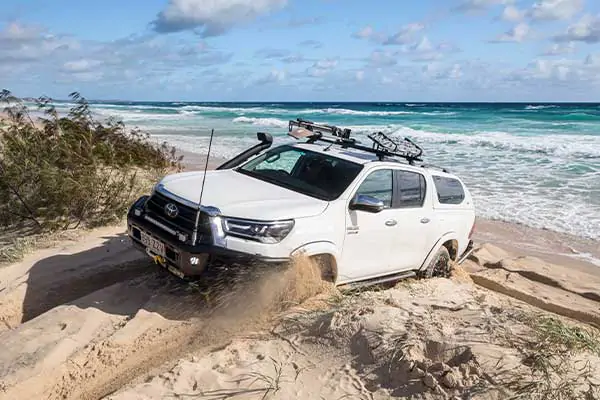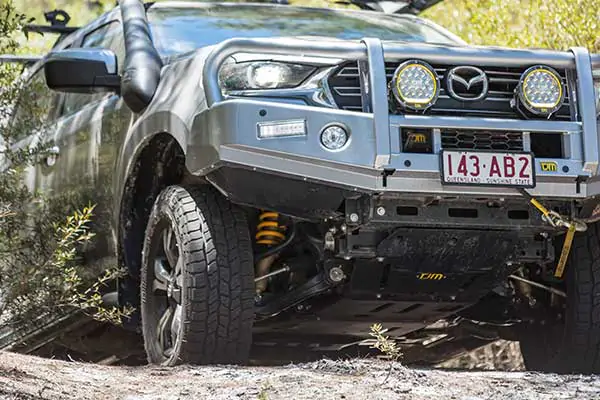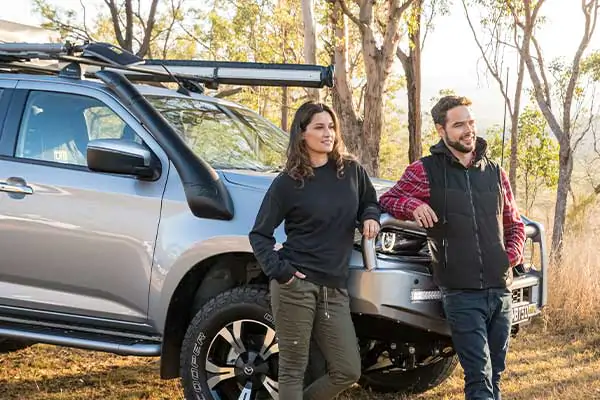Top 3 mods for your rig before going away (Inland or Beach)
Whether you’ve purchased a brand new 4x4 or grabbed a tried and true off-roader from a dealer, chances are you’re champing at the bit to get out there and explore the great outdoors. Now, before you load up your new rig with camping gear, an esky full of tinnies and a rod or two, there are a few modifications you’ll need to equip to avoid potential disaster.
Not sure where to start? Don’t worry, we’ve got you covered. We’ve outlined the top 3 mods your 4x4 needs for either coastal driving or treks through the outback.
Beach
All across Australia, there’s a whole host of mind-blowing beaches to see such as the infamous Bondi Beach, the tranquil Turquoise Beach in WA, along with the number one beach in the world for 2021, Whitehaven Beach in the Whitsundays.
But now, the latest acquisition to your garage has opened up a whole new world of jaw dropping beaches that are only accessible to those with a 4x4 – equipped with the right mods of course. So, now that you can get to these forbidden beaches, what do you need for trekking them?
1. Recovery points (bull bars & rears)

From novice first-timers to seasoned 4x4 vets, all of us can get stuck or bogged regardless of how well-equipped we are. It’s just part and parcel of exploring the great outdoors, however, it happens more times than you can count when you're trekking along the coast on sandy terrain.
To minimise the amount of times you get stuck, or at least lower the risk of getting stuck, immediately lower your tyre pressure to around 20 PSI. Lowering the tyre pressure elongates your tyres’ footprints, making it easier for your vehicle to gain traction, keep momentum and avoid a recovery situation. However, for moments where a recovery operation is required, you can’t be without Recovery Points on your 4x4.
Whether it’s a bull bar or a rear bar, these will need to be rated recovery points, meaning they’re designed to withstand a high pull force from a towing vehicle. We highly recommend having a rated recovery point at the front of the vehicle, as you’ll need to apply forward momentum to assist the towing vehicle in getting you unstuck. Most TJM Bull Bars come with rated recovery points as standard.
2. Roof rack

When it comes to recovery items or 4x4 accessories, for example recovery boards, high lift jacks and even shovels, they can take up a lot of valuable space in your cab. The best way to solve this is to equip a roof rack to your 4x4.
They’re nice and light, built tough and offer a whole host of tie down points to keep all your essential accessories, camping gear, kayaks, canoes and anything else you need nice and secure. You’ve also got somewhere to attach your awning for a nice bit of shade or shelter when you’re camping.
3. Winch
If you’re after that vital piece of solitude and find yourself driving alone along the coast, equipping a winch to your vehicle could just save your 4x4 - especially when cell service and supply points are few and far between.
Every recovery is different, and you need to make a call based on the individual circumstances. Snatch straps are great for many applications, but just remember they rely on another vehicle to help you out.
A winch, however, will pull slowly, allowing you to have a much greater level of control. It can also be anchored to a tree or another fixed object, allowing you to get yourself unstuck in remote environments.
If you do find yourself stuck in the sand, we recommend you avoid using a winch for recovery. The lack of traction and unstable terrain spell a recipe for disaster, and can actually pull the recovering/winching vehicle into the sand, possibly causing a second bogged 4x4. Stick to snatch straps and rated bow shackles if you can.
Inland
Tackling deserts, crossing treacherous waterways, scaling mountain ranges or barrelling through a forest is all part and parcel of exploring Australia’s outback. There’s mystery and beauty around every corner, but danger awaits for those under prepared for what the Australian landscape has to offer.
Fortunately, we’re here to provide the necessary information you need to kit your 4x4 out for any environment you find yourself across Australia.
1. Suspension

If you’ve bought yourself a new 4x4 from a dealership, chances are these beauties have been designed for the tarmac – not the Aussie bush. Why? It all comes down to the suspension.
Now, standard suspension simply isn’t going to cut it if you want to have a fair dinkum good look around and see what this land has to offer. Getting yourself a suspension upgrade gives you the ability to add travel and flex, along with extra ground clearance and, most importantly, keep your tyres on the ground, so they can do the job they’re designed to do.
At the end of the day, it doesn’t matter how good your tyres are, if they’re constantly off the ground and spinning in the air, you're going to have a mighty hard time trying to climb that rocky hill and compromise your safety.
Suspension is crucial to your vehicle’s ability to carry loads and pull something in tow, while it will also dictate how your 4WD responds while braking, accelerating, and cornering.
2. Air Intake (Snorkel)

No matter where you go in Australia, the second you leave the asphalt, you’re met with acres of dusty tracks and water crossings that could wreak havoc on your engine. The best way to combat this, get yourself a snorkel, pronto.
A snorkel is a device that fits onto your engine’s air intake and takes air from close to the roof level. The air quality up there is cleaner and cooler than air travelling through and around the bonnet, which means better fuel efficiency and less clogging of air filters when a snorkel is fitted.
It also allows your vehicle to continue to ‘breathe’, even as you’re passing through creeks and rivers that may be up to the doors! And if you get water into your engine bay, consider it buggered.
3. Bull Bar
When you’re trekking about the bush, there are quite a lot of vital accessories that could be placed right here in our number 3 spot. But when it comes to safety, nothing quite compares to the benefits offered by an all-steel bull bar.
After equipping a bull bar to the front of your 4x4, you’re immediately protecting your vehicle’s vital components at the front from potential animal strikes, as well as providing your vehicle with rated recovery points to get you out of strife.
It also allows you to mount important 4x4 accessories such as driving lights, fog lights, a winch and an aerial for a UHF radio (vital if you’re away from service or travelling in a convoy) to warn others or call for help from nearby travellers.



